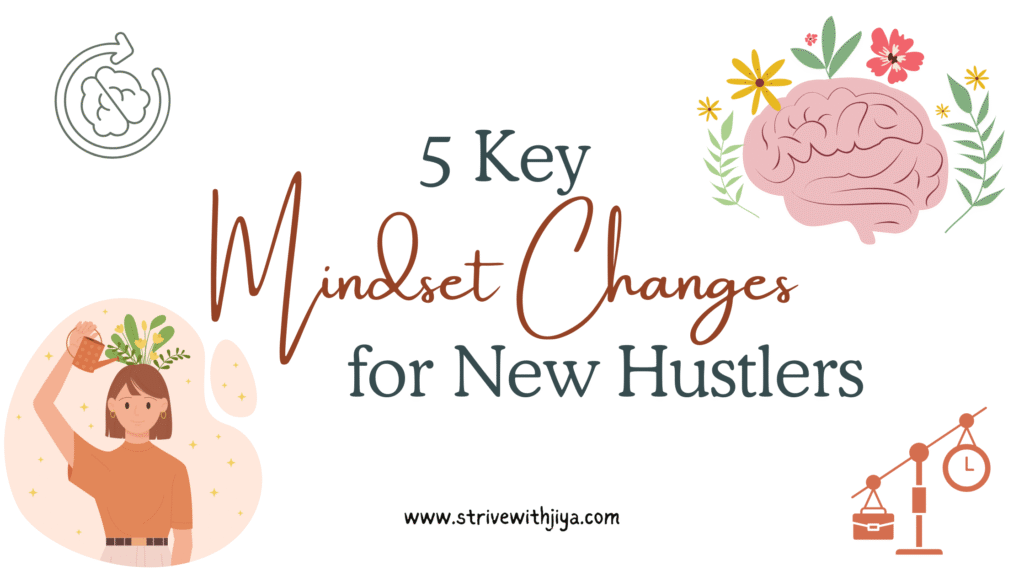
Starting your own blog can feel overwhelming at first but once you have a simple process in place, it becomes a lot more manageable (and even fun!). If you still haven’t created your blogging website, check out this guide where I have shared steps to start a blog that earns. In this post, I’m sharing the exact steps I follow to write, design, and share a blog post for Strive with Jiya. Whether you’re just starting out or trying to get more consistent with blogging, I hope this helps you build your own routine.
1. Choose a Topic and Title
Start by selecting a topic that aligns with your blog’s purpose and your audience’s interests. Once you have a topic in mind, come up with a title that’s clear and catchy. Your title should give readers a reason to click and should also reflect what the post is actually about.
2. Write a Draft
There are no rules here, just write! You can write it all by yourself, or get a little help from an AI tool if you’re stuck. The goal is to get your ideas out of your head and onto the page. Don’t worry about making it perfect at this stage.
3. Refine the Draft
Once your draft is ready, read through it a couple of times. Whether you wrote it yourself or used AI, editing is essential. Make sure everything flows well, fact-check any claims, and add your personal touch and voice. This is what makes your blog feel real and relatable.
Note: I personally write my initial rough draft and then ask AI to refine and organize everything depending on the type of article. Then I go through the AI refined version of my draft article and read it from start to finish, add or remove things and add my personal touch to it. Finally, I add links, images etc. to finalize everything.
4. Add Basic SEO
Before hitting publish, don’t forget the behind-the-scenes stuff:
- Make sure your article title is to the point and has important keywords. Try to keep the length under 60 characters.
- Write an excerpt or meta description (preferably below 160 characters).
- Add relevant keywords throughout the article.
- Format your headings (H1, H2, H3).
- If you are using WordPress, add “AIOSEO” plugin to help you with all these things.
These little details help your blog get discovered through search engines.
5. Add Links
Link to other helpful blog posts you’ve written, affiliate products, or tools you recommend. This not only boosts your SEO but also keeps readers engaged. Use a mix of internal links (your own content) and external links (useful outside resources).
6. Design Blog Graphics
Create a banner image that fits the vibe of your blog and reflects the post’s topic. You can also add extra graphics or quotes if needed, especially if you plan to break up long text with visuals. I personally do everything on Canva. If you have the budget to buy Canva pro that will give you more options but free version is great too!
7. Create a Pin & Instagram Post/Reel
I like to start with a Pinterest Pin, then copy that design into an Instagram reel template. From there, I just add animations and export. This saves time and keeps your branding consistent across platforms.
8. Share on Quora
Once the post is live, I promote it by:
- Sharing in my Quora Space that I made specifically for my website content. I use the same image that I created for Pinterest and generate a short caption using AI along with the link to my original article.
- Answering relevant questions and linking to my blog post (only when it’s genuinely helpful). Don’t spam on Quora or else you will get your account blocked.
9. Share on Pinterest
Pinterest is great for blog traffic! Simply upload your pin and add the direct link to your blog article in the destination URL.
10. Share on LinkedIn
Use the same Pinterest graphic, write or generate using AI a short caption or summary of the blog post, and paste the link. It’s a professional platform, so your blog could catch the eye of the right readers or collaborators.
11. Share on Instagram
Update the link in your bio or add it to your highlights. You can also use a reel or carousel to talk about the blog post and direct followers to the link.
12. Share on Facebook
You can either post on your page or your profile. If you’re auto-sharing from Instagram, just make sure to edit the caption a bit and paste the blog link directly into the caption or first comment for better reach.
This may seem like a long list, but once you get used to it, it becomes second nature. The key is consistency and finding a flow that works for you. Feel free to save or adapt this checklist for your own blog.
If you’re just starting out and have questions, feel free to reach out, I’d love to help!




